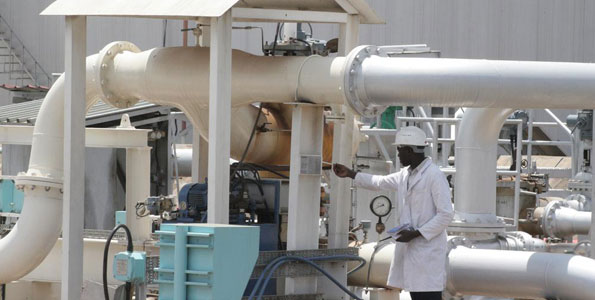
By James Anyanzwa
East African governments are dithering on funding the planned oil refinery in Hoima, Uganda, leaving the future of the multibillion-dollar project in doubt.
However, the Ugandan government says it is ready to go ahead with implementation of the project without the participation of the other East African Community member states.
Energy Minister Irene Muloni said the government is finalising discussions with the lead consortium and the contract is likely to be signed before the end of this month, paving the way for the construction. She said Uganda would take up all the shares not taken up by Tanzania, Rwanda, Burundi and Kenya.
The five EAC member states were allocated a combined 40 per cent shareholding in the facility — translating into a eight per cent stake for each — with the remainder of the shares reserved for private investors.
The deadline for confirmation of shareholding had been set for last November in order to allow Uganda to start negotiating with other strategic investors.
Kenya took up a 2.5 per cent stake worth $13 million last year, although the money is yet to be paid. Treasury Cabinet Secretary Henry Rotich however said the country will not take up more.
“Why should we take more shares in the refinery?†Mr Rotich asked. “They have not even started the construction. We have other strategic interests.â€
READ: Kenya acquires 2.5 pc stake in Uganda refinery
Meanwhile, Tanzania, Rwanda and Burundi are yet to commit themselves to the $4.3 billion facility. But now, Uganda, which initiated the project, has said it is ready to bear the burden of building the refinery on its own.
“The stakes that will not be taken up by the member states will be taken up by the government of Uganda,†said Ms Muloni.
Peter Kinuthia, the EAC’s senior energy officer, said the way forward is for Uganda to continue negotiating with private investors knowing that the EAC member states have a 40 per cent stake.
“If other member states don’t come in, Uganda will have to carry the burden itself,†he said.
The window for the EAC member states to participate in the project is swiftly closing with the proposed refinery expected to come on steam by 2018. The refinery, which is expected to process an estimated 60,000 barrels of oil per day, will initially output half of that capacity in 2018.
At a meeting of the EAC Sectoral Council on Energy last year, Tanzania and Burundi requested Uganda for more details about the project before making a decision. But although the Ugandan government furnished the two countries with the commercial reports on the feasibility of the project, they are yet to make a decision.
Mr Kinuthia said: “To my knowledge, these countries have not confirmed their shareholding participation in the refinery.
“Burundi and Tanzania wanted more commercial information about the project. They wanted to study a lot of documents before making a decision.
“Burundi has been very quiet over the project but I’m not aware of Uganda’s response to Tanzania in the context of the confidentiality agreement.
“Rwanda had indicated an interest but it has not confirmed the amount of stake it intends to take,†he concluded.
Uganda intends to construct the refinery to process the hydrocarbon reserves, estimated at 6.5 billion barrels, that lie on its border with the Democratic Republic of Congo. A consortium led by Russia’s RT Global Resources won the tender to build and operate the crude oil refinery.
The Ugandan government is also expected to accelerate the formation of both the National Oil Company (NOC) and the National Refining Company (NRC) as conditions for the formation of the special purpose vehicle to implement the refinery development project.
Uganda’s refinery project was mooted following a study of regional refineries that was commissioned by the EAC in 2008. A taskforce comprising officers from the petroleum sub-sector in the EAC was created to undertake the study. It advised that a refinery be constructed near the then-recently discovered oil fields in Uganda.
The taskforce also recommended acceleration of the upgrading of the Mombasa-based Kenya Petroleum Refineries Ltd (KPRL) and installation of additional storage facilities in Uganda to ensure strategic coverage at least 30 days of operation.
Kenya has since parted ways with its co-shareholder Essar Energy of India in the running of KPRL, leaving the government with the task of deciding what to do with the 55-year-old refinery whose inefficiency has cost oil marketers close to Ksh3.5 billion ($34 million) since the closure of the facility on September 4, 2013.
“Oil dealers are owed a huge debt, in excess of Ksh3.5 billion, following closure of the refinery,†said Polycarp Igathe, the chairman of Petroleum Institute of East Africa (PIEA).â€
In the meantime, Kenya is considering whether to convert the refinery into a storage facility and build a new refinery that is more efficient or bring in a new investor, although oil marketers are of the view that it should not be closed down but be upgraded to improve efficiency.
“My position is that Kenya must invest in upgrading its refinery,†said Mr Igathe. “The upgrade will ensure more white oil production.
“Kenya must also ensure that it gets the right partner in the refinery. A partner who has the integrity, capacity and capability to invest in refinery technology.â€
KPRL, which is the only refinery in East Africa, produces liquefied petroleum gas, petrol, diesel, kerosene and fuel oil. Its products serve customers in Kenya, Uganda, Rwanda, Burundi, Tanzania and parts of DRC.
OP The East African



Recent Comments